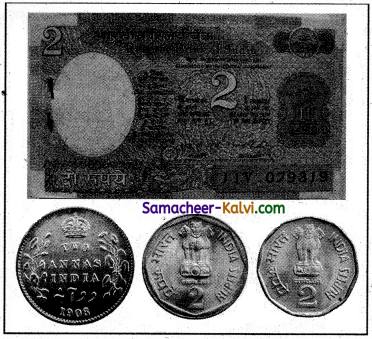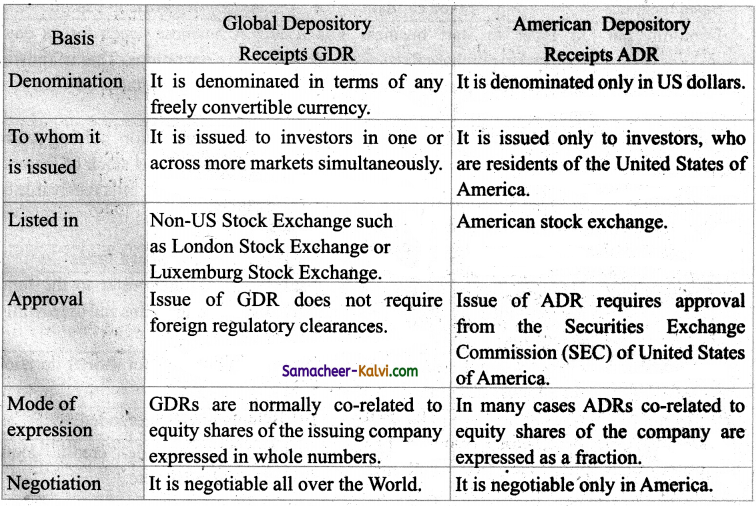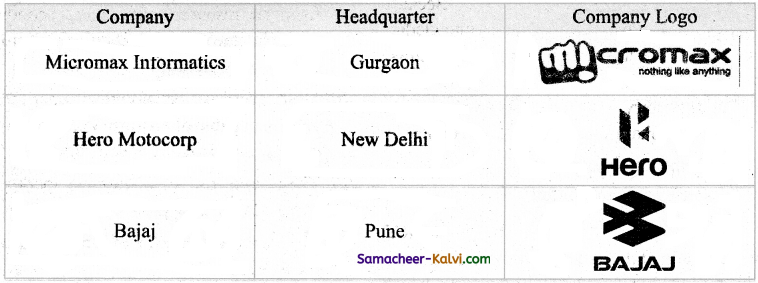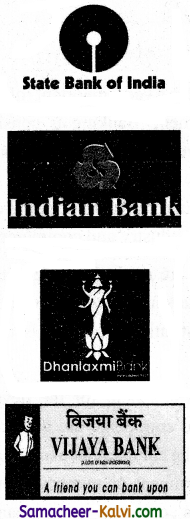TN State Board 11th Commerce Important Questions Chapter 32 Direct Taxes
Question 1.
What is Income tax?
Answer:
Tax is a compulsory contribution to state revenue by the Government. It is levied on the income or profits from business of individuals and institutions.
Question 2.
What is meant by previous year?
Answer:
- The year of earning income is called ‘Previous Year’.
- The year in which assessment of income is done is called ‘Assessment Year’.
- The income tax return of previous year’s income is filed in the relevant assessment year.
![]()
Question 3.
Define the term person?
Answer:
The term ‘person’ has been defined under the Income tax Act. It includes Individual, Hindu Undivided Family, Firm, Company, Local authority, Association of person or body of Individual or any other artificial juridical persons.
Question 4.
Define the term assessee?
Answer:
- Assessee means a person by whom any tax or any other sum of money is payable under this Act.
- It includes every person in respect of whom any proceeding has been taken for the assessment of his income or assessment.
Question 5.
What is an assessment year?
Answer:
- The year in which tax is paid is called the assessment year.
- It normally consisting of a period of 12 months commencing on 1st April every year . and ending on 31st March of the following year.
![]()
Question 6.
What is Gross Total Income?
Answer:
Income from five heads namely salaries, house property, profits and gains of business or profession, capital gains and other sources, in computed separately according to the provisions given in the Act. Income computed under these heads shall be aggregated after adjusting past and present losses and the total so arrived at is known as ‘Gross Total Income’.
Question 7.
List out the five heads of income.
Answer:
These five heads of income are:
- Income from ‘Salaries’ [Sections 15-17];
- Income from 4House Property’ [Sections 22-27];
- Income from ‘Profits and Gains of Business or Profession’ [Sections 28- 44];
- Income from ‘Capital Gains’ [Sections 45-55]; and
- Income from ‘Other Sources’ [Sections 56-59].
Question 8.
Write a note on Agricultural Income.
Answer:
Any rent or revenue derived from land which is situated in India and is used for agriculture purposes. Agricultural income is fully exempted from tax u/s 10(1) and as such does not form part of total income.
![]()
Question 9.
What do you mean by Total Income.
Answer:
Out of Gross Total Income, Income tax Act 1961 allows certain deductions under section 80. After allowing these deductions the figure which we arrive at is called ‘Total Income’ and on this figure tax liability is computed at the prescribed rates.
Gross Total Income * * * *
Less Deductions (Sec.80C to 80U) * * * *
Total Income (T.I.) * * * *
80C Deductions:
Contribution to Provident Fund, life Insurance Premium, Children’s Tuition Fees, Health Insurance Premium, Investment in National Savings Certificate, interest paid for home loans, etc.
Question 10.
Write short notes on:
(i) Direct Tax,
(ii) Indirect Tax.
Answer:
(i) Direct Tax:
If a tax levied on the income or wealth of a person and is paid by that person (or his office) directly to the Government, it is called direct tax e.g. Income-Tax, Wealth Tax, Capital Gains Tax, Securities Transaction Tax, Fringe Benefits Tax (from 2005), Banking Cash Transaction Tax (for ₹ 50,000 and above – from 2005), etc. In India all direct taxes are levied and administered by Central Board of Direct Taxes.
(ii) Indirect Tax:
If tax is levied on the goods or services of a person (seller). It is collected from the buyers and is paid by seller to the Government. It is called indirect tax. eg: GST.
![]()
Question 11.
Elucidate any five features of Income Tax.
Answer:
(i) Levied as Per the Constitution:
Income tax is levied in India by virtue of entry No. 82 of list I (Union List) of Seventh Schedule to the Article 246 of the Constitution of India.
(ii) Levied by Central Government:
Income tax is charged by the Central Government on all incomes other than agricultural income. However, the power to charge income tax on agricultural income has been vested with the State Government as per entry 46 of list II, i.e., State List.
(iii) Direct Tax:
Income tax is direct tax. It is because the liability to deposit and ultimate burden are on same person. The person earning income is liable to pay income tax Out of his own pocket and cannot pass on the burden of tax to another person.
(iv) Annual Tax:
Income tax is an annual tax because it is the income of a particular year which is chargeable to tax.
(v) Tax on Person:
It is a tax on income earned by a person. The term ‘person’ has been defined under the Income tax Act. It includes individual, Hindu Undivided Family.
(vi) Tax on Income: It is a tax on income.
The Income tax Act has defined the term income and it includes salary income, house property income etc.
(vii) Applicability:
Income Tax is applicable throughout India including the state of Jammu and Kashmir.
Question 12.
Define Tax. Explain the term direct tax and indirect tax with an example.
Answer:
Tax is a compulsory contribution to state revenue by the Government. It is levied on the income or profits from business of individuals and institutions. It may be added to the price of goods, services of transactions. Tax is the basic source of revenue to the Government, This revenue is utilised for the expenses of civil administration, internal and external security, building infrastructure, etc.
Types of Taxes:
There are two types of taxes – direct taxes and indirect taxes.
(i) Direct Tax:
If a tax levied on the income or wealth of a person and is paid by that person (or his office) directly to the
Government, it is called direct tax e.gIncome-Tax, Wealth Tax, Capital Gains Tax, Securities Transaction Tax, Fringe Benefits Tax (from 2005), Banking Cash Transaction Tax (for ₹ 50,000 and above – from 2005), etc. In India all direct taxes are levied and administered by Central Board of Direct Taxes.
(ii) Indirect Tax:
If tax is levied on the goods or services of a person (seller). It is collected from the buyers and is paid by seller to the Government. It is called indirect tax. eg: GST.
(iii) Income Tax:
Income tax is a direct tax under which tax is calculated on the income, gains or profits earned by a person such as individuals and other artificial entities (a partnership firm, company, etc.)
![]()
Question 13.
List out any ten kinds of incomes chargeable under the head income tax.
Answer:
Income includes the followings:
- Profits and gains of business or profession.
- Dividend.
- Voluntary contribution received by a charitable / religious trust or university / education institution or hospital/ electoral trust [w.e.f. 01.04.2010]
- Value of perquisite or profit in lieu of salary taxable u/s 17 and social allowance or benefit specifically granted either to meet personal expenses or for performance of duties of an office or an employment of profit.
- Export incentives, like duty drawback, cash compensatory support, sale of licenses, etc.
- Interest, salary bonus, commission earned by a partner of a firm from such firm.
- Capital gain chargeable u/s 45.
- Profits and gains from the business of banking carried on by a co-operative society with’the members.
- Winning from lotteries, crossword puzzles, races including horse races, card games and other games of any sort or from gambling or betting of any form or nature what so ever.
- Deemed income u/s 41 or 59.
Question 14.
Discuss the various kinds of assessee.
Answer:
Assessee means a person by whom any tax or any other sum of money is payable under this Act. It includes every person in respect of whom any proceeding has been taken for the assessment of his income or assessment of fringe benefits.
Kinds of assessee:
(i) Ordinary person or an individual he is an ordinary assessee:
(a) The persons who are covered under income tax Act are called assesse.
(b) Every person want to pay income tax out of receiving salaries or income from house properties. Any person who is entitled to refund of tax
(ii) Representative assessee:
(a) A person may not be lichle only for his own profit or loss but also on the profit or loss of other persons, eg: guardian of a minor, Agent of non-resident,
(b) In the above case one person who is responsible for the assessment of income of such persons are called representative to be an assessee.
(iii) Assesssee in default:
(a) A person is deemed to be an assessee in default. If he fails to fulfil his statutory obligations.
(b) In case an employer paying salary or professional employer ’s duty is the deduct tax source and deposit the amount of tax. So collected in treasury,
(c) If a person fails to deduct tax at source or deduct tax but does not deposit in the treasury. He is known as treasury in default.
![]()
Choose the Correct Answer:
Question 1.
Income Tax is:
(a) a business tax
(b) a direct tax
(c) an indirect tax
(d) none of these
Answer:
(b) a direct tax
Question 2.
Period of assessment year is:
(a) 1st April to 31st March
(b) 1st March to 28th Feb
(c) 1st July to 30th June
(d) 1st Jan. to 31st Dec.
Answer:
(a) 1st April to 31st March
Question 3.
The year in which income is earned is known as:
(a) assessment year
(b) previous year
(c) light year
(d) calendar year
Answer:
(b) previous year
![]()
Question 4.
The aggregate income under five heads is termed as:
(a) gross total income
(b) total income
(c) salary income
(d) business Income
Answer:
(b) total income
Question 5.
Agricultural income earned in India is:
(a) Fully Taxable
(b) Fully Exempted
(c) Not Considered for Income
(d) None of the above
Answer:
(b) Fully Exempted
![]()
Samacheer Kalvi 11th Commerce Notes Chapter 32 Direct Taxes
→ Tax is a contribution to state revenue by the government. It is levied on the income or profits from business of individuals and institutions. It may be added to the price of goods, services or transactions. Tax is the basic source of revenue to the government. This revenue is utilized for the expenses of civil administration. Internal and external security, building infrastructure, etc.
→ There are two types of taxes direct tax and indirect tax.
→ Direct tax:
If a tax levied on the income or wealth of a person and is paid by that person (or his office) directly to the government. It is called direct tax. eg: Income tax, wealth tax. In India all direct taxes are levied and administered by central board of direct taxes.
→ Indirect tax:
If tax is levied on the goods, or services of a person(seller). It is collected from the buyers and is paid by seller to the government. It is called indirect tax. eg: GST Income tax is a direct tax under which tax is calculated on the income, gains or profits earned by a person such as individuals and other artificial entities (a partnership firm, company, etc) Features of income tax in India.
- Levied as per the constitution
- Levied by central government
- Direct tax
- Annual tax
- Tax on person
- Tax on income
- Income of “previous year” is assessable in “assessment year”.
- Charged at prescribed rates.
- Administrated by the central government.
- Applicability.




